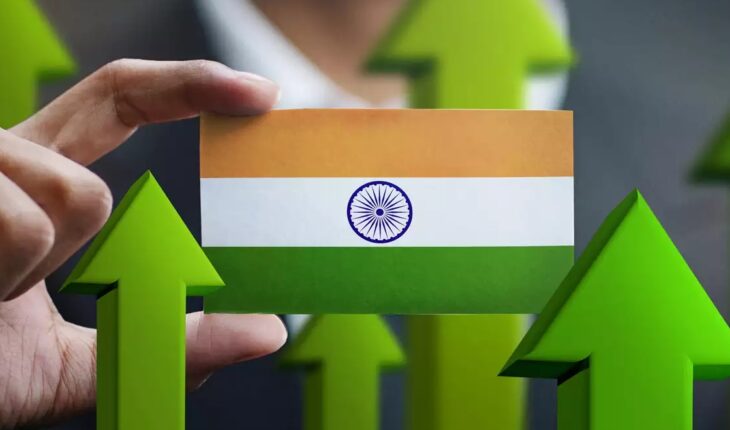
According to media reports, on November 19, for the first time, India’s gross domestic product (GDP) crossed the $4 trillion (4 trillion) mark. However, this has not been confirmed yet by the Finance Ministry or the National Statistics Office. India’s GDP was $1 trillion in 2007, increasing to $2 trillion in 2014, $3 trillion in 2019, and $4 trillion in 2023.
At present, USA is the world’s largest economy with a GDP of $26.70 trillion, while China is at second place with GDP of $19.24 trillion, Japan is at third place with GDP of $4.39 trillion and Germany is at fourth place with GDP of $4.28 trillion. While India is now at fifth position with $4 trillion. However, even earlier India was the fifth largest economy in the world.
India’s GDP grew at the rate of 6.39 percent in 2013, 7.41 percent in 2014, 8.00 percent in 2015, 8.26 percent in 2016, 6.80 percent in 2017, and 6.45 percent in 2018. It will grow at the rate of 3.87 percent in 2019, at the rate of minus 5.83 percent in 2020, at the rate of 9.05 percent in 2021 and at the rate of 7.00 percent in 2022.
On November 15, Union Finance Minister Smt. Nirmala Sitharaman, while addressing the “Indo Pacific Regional Dialogue”, said that India will become the world’s third largest economy by 2027, surpassing Japan and Germany. According to the International Monetary Fund (IMF), India will become the third largest economy in the world in 2027. Not only this, according to IMF, there is a strong possibility of India becoming a developed country by 2047.
S&P Global Market Intelligence also says that India could become the world’s third largest economy by 2030, overtaking Japan. The agency also says that India’s GDP can cross the level of US $ 7300 billion in 2030. Further, S&P Global India Services believes that despite the Corona pandemic, high fuel prices in the global market and geopolitical crisis, India maintained the strength of the economy in 2021 and 2022 and now the Indian economy remains bullish in 2023. On this basis, it is being speculated that India’s GDP growth rate in the financial year 2023-24 could be between 6.2 to 6.3 percent, because the GDP growth rate in the June quarter of the current financial year was 7.8 percent.
In the month of October, gold import in the country increased by 60 percent compared to last year to the level of 123 tonnes, which is the highest level in 31 months. The amount increased from $3.7 billion in October 2022 to $7.23 billion in October 2023. In this regard, Mr. Nilesh Shah, a temporary member of the Prime Minister’s Economic Advisory Council (PM-EAC), said on November 20 that in the last 21 years, India has spent 500 billion dollars on the import of gold. If India had not imported gold in such large quantities and the people of India had invested in Indian companies instead of gold, our economy would have become worth 5 trillion dollars long ago. Since people of India forget to invest in gold, due to which a huge amount remains idle and is not reflected in the GDP.
The most important among the economic reforms initiated by the government is the introduction of the Goods and Services Tax (GST) in 2017. The government’s revenue is continuously increasing through this new tax system. GST collection in the month of October stood at Rs.1.72 lakh crore, which is 13 percent more than in October 2022 and is Rs.1.51 lakh crore in amount. GST collection in the month of September was Rs.1.63 lakh crore. Most importantly, for the 8th consecutive time, GST collection has been more than Rs.1.5 lakh crore, whereas for the last 20 months, GST collection has been above Rs.1.4 lakh crore. However, the highest GST collection was Rs.1.87 lakh crore in April 2023 and in the last 7 months in the financial year 2023-24, GST collection of Rs.11.65 lakh crore has been made, while in the financial year 2022-23, the total GST collection is Rs.18.10 lakh crore.
In terms of Gross State Domestic Product (GSPD), the highest increase in the last one year has happened in Delhi. This has crossed the level of Rs 2,60,559 in the financial year 2019-20, before the Corona pandemic. Here, the per capita GSPD has also increased by Rs.19,000/- Sikkim is at second place in this matter, where last year there was an increase of Rs.13,500/-in GSPD per person.
According to the data released by the Reserve Bank of India, Uttar Pradesh stood first in terms of manufacturing last year, where the manufacturing sector grew at the rate of 15.5 percent, while Uttarakhand was at second place, where it grew at the rate of 9.2 percent. In Haryana, this increase in this area has been recorded at 5.8 percent. At the same time, this increase has been 3.41 percent in Chhattisgarh, 5.21 percent in Madhya Pradesh and 4.98 percent in Rajasthan. However, data in this regard is not available for Gujarat, Maharashtra, and Chandigarh.
GDP is the most effective way to measure the health of the economy. It represents the value of all products and services at a given time. In this, the foreign companies which produce within the country’s borders are also included. When the GDP rate is better, the level of unemployment in the country is usually lower. There are two types of GDP. Real GDP and Nominal GDP. Real GDP calculates the prices of goods and services at constant prices in the base year. At present, GDP is calculated based on base year 2011-12, that is, it is calculated at the rate of price of goods and services in the financial year 2011-12. Whereas nominal GDP is calculated based on current price.
The main reasons for increase or decrease in GDP are expenditure by private and government sectors, increase or decrease in private sector business, etc. Apart from this, net demand, which is calculated by subtracting imports from exports, is also a major factor affecting the rate of GDP. Since, India’s exports are always less than imports, hence, it negatively affects the GDP.
During the Corona pandemic, the appropriate policies of the government and the Reserve Bank of India helped the Indian economy to come out of the negative effects of the pandemic and due to the economic reforms initiated by the government, the economy got strengthened and the banking sector also remained healthy and strong. Implementation of Pradhan Mantri Mudra Yojana and PM Swanidhi Yojana increased employment or self-employment opportunities, which increased the demand for diverse products.
The most important thing is that now development is taking place even in those states which were earlier standing in the back rows. Be it GSPD or manufacturing sector, Uttar Pradesh is performing better in all sectors. Some other backward states are also now performing remarkably on development parameters. What this means is that the train of development is no longer running on the strength of only a few states. The participation of other states is increasing steadily and due to this, India’s GDP is growing at a fast pace.
Satish Singh, Ahmedabad based Senior Columnist,Views are personal






